Fire Emblem Fates: Birthright Nintendo 3DS Review: Blood Will Tell
Intelligent Systems offers Fire Emblem: Awakening fans a true sequel.
This article first appeared on USgamer, a partner publication of VG247. Some content, such as this article, has been migrated to VG247 for posterity after USgamer's closure - but it has not been edited or further vetted by the VG247 team.
Fire Emblem: Awakening was the make it or break it game in the series. If it didn't sell well enough, that was the end of the series. So Intelligent Systems made some changes to the Fire Emblem formula. The visual presentation was improved over previous games with animated cutscenes, voice acting, and the distinct character designs of Yosuke Kozaki. The social aspects of the game were increased with more dialog, unique character conversations, and the Pair Up battle mechanic. Most importantly, permadeath, a series staple up until that point, could finally be disabled in the options screen.

Fire Emblem Fates: Birthright is a continuation along that path. Birthright itself is a fantastic experience if you enjoy strategy, base-building, and an extensive romance game, but don't want to slam your head into battles again and again. That's not to say that Birthright is dead simple: the game will still challenge you and I did lose party members during battles, but you're given far more options as to how difficult you want your experience to be.
These options include three difficulty settings (Normal, Hard, and Lunatic) alongside three ways of handling death. Phoenix Mode brings your party members back to life between turns and the only way you can really lose is to have your Avatar die or fail an objective. Casual Mode is like Awakening, with party members staying out of combat when they die, but returning to action after the battle. Then there's Classic Mode, which is means that if a character dies, they're gone forever. You can lower the difficulty once chosen, but you can't raise it, so choose wisely.
Once you've chosen your difficulty mode and death style, you're thrown into the game's opening chapters. Here the story of the Avatar is explained and Fates' gameplay systems are revealed in tutorial levels. The first five chapters of any game in Fire Emblem Fates are comprised of these shared chapters, which you can complete in 2 hours tops. Once you've cleared it once, the game even offers the option to start over again at the major choice pivot in Chapter 6.
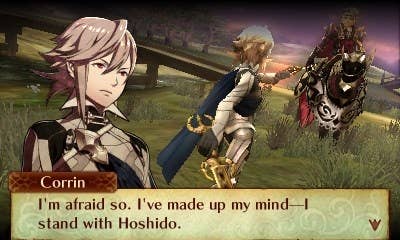
The Avatar was born of the noble and peaceful Hoshido clan, but treachery found him or her as an adopted member of the warlike Nohr royal family. When both clans meet on the field of battle, both families call claim to you, but you ultimately decide who you wish to go with. Birthright assumes that you choose your birth family and want to stop the encroaching madness of the Nohrian king, Garon. It's a story about learning who your family is and your place in a world of two families, both descended from dragons. It's well told, with semi-voiced vignettes, great 2D art, 3D models, and the occasional fully-animated cutscenes
Row, Row! Fight the Power!
Most of Fire Emblem Fates is given over to combat, which takes place on various maps built on a grid. These maps are full of various terrain that imparts benefits or drawbacks to player and a whole host of opponents, hidden behind various chokepoints and barriers. If you've played any strategy game, you know what to expect: every character has different movement abilities or other skills to help them out on the battlefield.
Fire Emblem Fates also adds Dragon Veins, spots on each map where royal family members can activate special map-changing abilities, like healing everyone in a region, flattening land, building a bridge, or clearing out rubble. Dragon Veins are optional facets that can turn the tide of battle or offer new ways forward for your crew.

Fire Emblem Fates is a very social game, focusing on the connections between characters and this is readily apparent in the combat sections. Units that are adjacent to each other will fight in combat together, adding another attack, defending a strong hit, or simply offering a temporary stat boost.
This can be strengthened with the Pair Up system, which returns from Fire Emblem: Awakening. When you Pair Up two units, they operate as a single switchable unit, with the strengths of both parties. The idea is you cover the gaps in certain characters, like fixing my low-defense main character by pairing him with a high-defense Sky Knight (Hey, Hinoka!). Fighting together, either through Pair Up or Adjacent combat, also increases your characters' support ranks, making them stronger together and more likely to romance one another. (More on that later).
Combat may be easier in Birthright, but there's still a ton of variables you have to keep track of if you want to get really good. Let's start with weapons as an example. Right off the bat, certain classes can only use certain weapons and those weapons have various weapon ranks. Use a weapon more with a character and that weapon will rank up, meaning you can use stronger weapons in that same class.
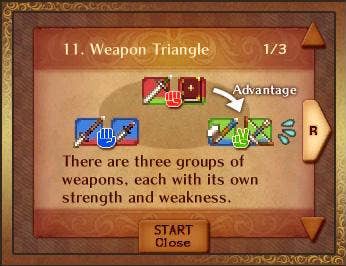
The Weapon Triangle means that certain weapons beat others in a Rock, Paper, Scissors-style manner: Red (Sword and Tomes) beats Green (Axes, Clubs, and Bows), which beats Blue (Spears, Daggers, and Shuriken), which in turn triumphs over Red. These equipped weapons are also occasionally strong against a certain class, like bows, which absolutely wreck any Sky Knight or its related advanced classes. I keep a piece of paper with the weapon triangle near me at all times and the game will helpfully let you know when you run across an enemy that has weapon that can put some real hurt on you, via an exclamation marks above their heads.
This means army composition is very important. You need to look at what your enemy is bringing to bear before the battle; if you glance over the map and see a lot of Red, you're better off taking your ninjas, maids, and knights into battle. Their Blue weapons will trump Reds. Is there an Archer at a chokepoint? Don't send your Sky Knight ahead, send an axe-wielding Oni Savage to soften that Archer up. Regardless of difficulty level, proper planning will keep your team alive.
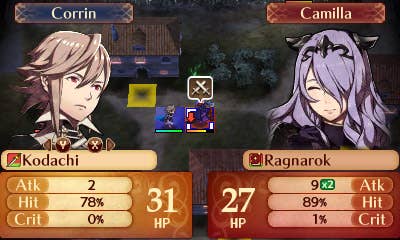
So will leveling up your team. Birthright allows you complete Challenge maps that recharge over time, or alternatively, you can pay gold to create new Challenge maps. My guess is Birthright players may have longer play times than their Conquest counterparts, merely because they have the option to grind between chapters.
This is very helpful, because Fire Emblem Fates still has no shared experience system. If you get a new character that's lower-level than your main squad - like many of the extra characters you can earn in Paralogues - you have to take that character into battle to level them. They have to deal damage, regardless of how weak they are, because the experience gains while being a support are rather low. (My best healer is my Maid, because she can use healing Staves and Knives to heal and attack, unlike my Staff-only Shrine Maiden sister. Why you so useless, Sakura?)
All of this is before you get to the class system, promotions, class skills, and using seals to mess with all that, which is far too complex for the purposes of this review. Suffice it to say, it's a lot.
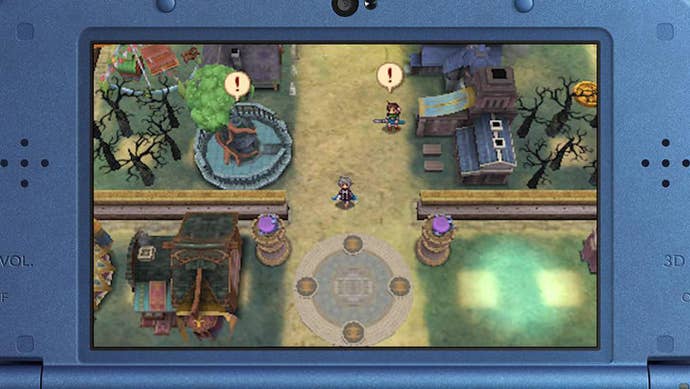
Fortress and Chill
When you're not out bashing heads in search of lost family members or larger truths, you spend your time are your extra-dimensional homebase. Your Castle is a completely customizable area: you can change the overall styles (Are cherry blossoms are rocky deserts more to your liking?), the music, your personal assistant, and the name of your castle. You can also use Dragon Vein Points (DVP), gained through finishing story chapters, challenges, or paralogues, to add new buildings to your Castle area.
These buildings include various vendors, a prison for converting captured enemies to your cause, a relaxing hot spring, and Lilith's Temple, where your helpful fledgling dragon stays. An Accessory shop gives you the chance to really customize your favorite characters with hats, glasses, masks, armor, and even a bath towel if you can afford it., You can place the buildings anywhere within reason and the ultimate effect is it feels like a home. You can wander around and talk to your characters, which will sometimes give you benefits. You can even view your town in 3D if you so choose.

Your Private Quarters is one of the two centerpieces of your fortress. Here you can change your hairstyle, or invite your characters over for a nice chat. This was where the touching mini-game was in the Japanese version of Fates, but you'll still get the voiced dialog and the stunning Live2D artwork in the Western release. And if you reach the S-level support rank with a character, a version of the touching mini-game is still available. You just can't touch every character willy nilly.
Occasionally, invading armies will attack your fortress, trying to destroy your buildings and take your throne. Strike that, they will destroy your buildings, even if they don't take your throne. Don't worry though, those buildings return once you win the battle. I remember my heart sinking when an enemy destroyed my Mess Hall, only to see it pop up, right as rain after the battle.
Your castle area seems to run on a daily schedule, with certain things only available for use once a day. I think heading into a battle moves the Castle clock forward, but I'm not 100 percent sure on that one yet. Regardless, the idea is that you return from time to time to check in on your army and get some free stuff. This is also where you'll meet Marth, Ike, Lucina, and Robin, if you happen to have their Amiibo. (I do.)
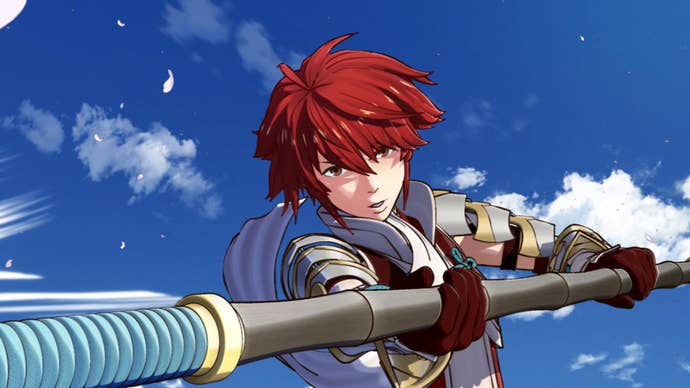
Romancing Saga
As I've said, Fire Emblem is a very social game at this point. Every single named character has a full 3D model you can customize to your heart's content. There's a ton of dialog: every character has a number of support conversations with every other character, including your Avatar. Every conversation is illuminating and fleshes out both people taking part in the conversation.
It's in the conversations and asides where you'll find your favorite characters. I thought the maid Felicia would annoy me, but I find her enthusiasm and odd voice inflections to be weirdly endearing. Or there's the off-beat, dandere-style Setsuna, the perennially perfect Subaki, or the bloodthirsty Oboro. You'll eventually find your favorites, even if they aren't the characters who will always do well for you on the battlefield.
Eventually, you'll find yourself getting married, or find two other characters getting hitched to one another. The child system isn't really all that fleshed out, adding just a few more characters to your army than before. I would've preferred something a bit more robust, like Record of Agarest War or Phantasy Star III, but beggars can't be choosers.
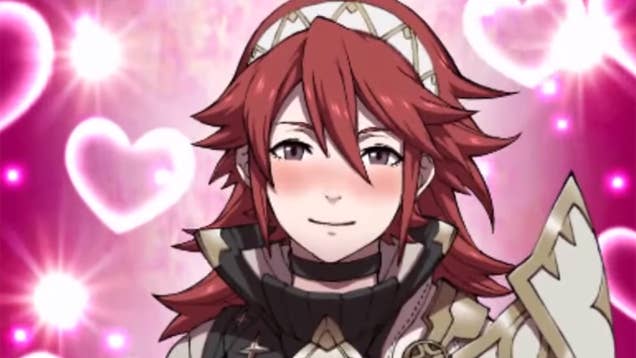
This is probably the place that newer Fire Emblem players will find themselves most at home. The faux dating sim aspects are pretty endearing, seeing members of your army become closer and closer is like watching a tiny digital drama that takes place during a war. It's why Intelligent Systems added Phoenix Mode, so you can breeze through the combat to get to the romance, not unlike how some people played Mass Effect. If that's your thing, the developer didn't let you down.
Campaign's End
When you cross the 25+ chapter finish line, Birthright comes across as more satisfying than Awakening. The difficulty spikes upwards towards the last few chapters, but by that point, you should have a solid understanding of the gameplay systems. Either way, you'll be emotionally tied to nearly every member in your army, which only makes the story resonate even stronger. Is it an amazing plot? No, but you will feel the pain of the sacrifices that have to be made.
When you round the corner, Fire Emblem Fates is every bit as satisfying as Fire Emblem: Awakening before it. If you care about the romance as much as the strategy, Birthright is the version you need to buy.
InterfaceFire Emblem Fates has an attractive interface that is easy to use, which is useful in light of the various systems at play.
Lasting AppealAfter polishing off Birthright, you'll probably jump to Revelations, or the harder Conquest. Even if you don't you probably have more conversations to unlock and more customization to do to your army.
VisualsFire Emblem Fates is one of the best-looking games on the Nintendo 3DS. It cel-shaded cutscenes are particularly excellent.
ConclusionFire Emblem Fates: Birthright is a great followup to the amazing Fire Emblem: Awakening. The story is solid, the tactical combat is great, if simplistic in this version, and the characters are wonderfully endearing. The game excels in providing options, letting players tailor how they want to experience this world. If you care more or equally about the romance and social aspects of Fire Emblem, this is the version you should be playing.

